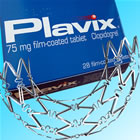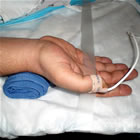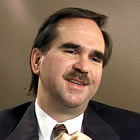 On May 17, less than two weeks from now, U.S. patent protection will end for Plavix (clopidogrel), the best-selling antiplatelet drug made by Bristol-Myers Squibb / Sanofi-Aventis. In 2010, worldwide sales of Plavix topped $6 billion (yes…billion!). For a typical stent patient, one 75mg tablet of Plavix a day costs more than $210 a month. Those with drug-eluting stents (80% or more of patients) must take Plavix for a year minimum. So the required medication actually can cost more than the stent itself. Continue reading
On May 17, less than two weeks from now, U.S. patent protection will end for Plavix (clopidogrel), the best-selling antiplatelet drug made by Bristol-Myers Squibb / Sanofi-Aventis. In 2010, worldwide sales of Plavix topped $6 billion (yes…billion!). For a typical stent patient, one 75mg tablet of Plavix a day costs more than $210 a month. Those with drug-eluting stents (80% or more of patients) must take Plavix for a year minimum. So the required medication actually can cost more than the stent itself. Continue reading
Attention Stent Patients: Plavix Going Generic!
Filed under Antiplatelet Medications, Patient Experience
Q&A with Dr. Jennifer Tremmel of Stanford

Jennifer Tremmel, MD
The Stanford School of Medicine blog “SCOPE” is featuring an “Ask the Doctor About Women’s Heart Health” article. The doctor is Jennifer Tremmel, MD, Clinical Director of Women’s Heart Health at Stanford Clinic, and Dr. Tremmel is no stranger to us here at Angioplasty.Org. You can read our interview with Dr. Tremmel about her experience starting the transradial approach to angioplasty at Stanford (she is also Director of Transradial Intervention there). Continue reading
Filed under FFR, Myocardial Bridging
20th Anniversary of Transradial Angioplasty

Radial Approach
We were honored to gain a new Twitter follower today: Dr. Ferdinand Kiemeneij, the “father of transradial intervention”, who notified us that this year is the 20th anniversary of the first transradial intervention: angioplasty done through the radial artery in the wrist. It was 1992 in Amsterdam that Dr. Kiemeneij’s group first began exploring ways to use the radial artery for interventional procedures, such as delivering balloons and stents. They were somewhat limited by the early equipment, but as catheters and stents became lower profile, thinner and easier to manipulate, the ability of physicians to use the radial artery increased. Most devices today can be delivered successfully using the radial artery. Continue reading
Filed under Innovators, Transradial Approach
Geoff Hartzler, Angioplasty Pioneer: In Memoriam

Geoffrey O. Hartzler, MD
Anyone reading this, whose life has been saved by an emergency angioplasty, a procedure which stops a heart attack in its tracks, should pause for a moment in remembrance of and thanks to Dr. Geoffrey Hartzler, an early pioneer of angioplasty, who in 1980 first opened up a patient’s blocked coronary artery during an acute myocardial infarction (see video below.) Dr. Hartzler passed away on Saturday, March 10, at age 65. I knew he had been fighting cancer, but I was saddened to read the news, first reported earlier today by Mike O’Riordan on theheart.org.
Geoff was truly a pioneer because, at the time, conventional wisdom argued against putting a balloon (this was pre-stent) into an artery that was causing an infarct. But he did, and he saved his patient’s heart and probably his life. Angioplasty has since become the “gold standard” for the emergency treatment of acute myocardial infarction. It has radically changed the prognosis for heart attack patients, virtually eliminating the devastating effects of an acute MI, if treatment is administered in time. Continue reading
Filed under History, Innovators, Video
Myocardial Bridging: Heart Patients and Social Networking

Reyna Roble
Angioplasty.Org’s Heart Patient Forum contains 10,000 posts in 200 topics; it receives 50,000 page views a month, from Boston and Biloxi to Britain and Bangladesh. Patients share stories and questions about heart disease, stents, angioplasty, bypass surgery, allergic reactions, medications and the occasional “odd” topic — in this case “Myocardial Bridging.”
Well, not so odd to Reyna Robles, one of the many women who have posted to this topic, trying to find help, trying to find others in their situation, trying to find answers. Continue reading
Filed under Myocardial Bridging, Patient Experience, Social Networking
Remarkable Stent Procedure
 As I have written before, many, many times, our Patient Forum on Angioplasty.Org is filled with thousands of patients asking questions that were not sufficiently answered by their doctors, patients wanting to know more about their procedure, their disease, why they feel the way they do after the procedure, how much activity is “safe”, why they still have a pain in their leg, etc., etc., etc. Continue reading
As I have written before, many, many times, our Patient Forum on Angioplasty.Org is filled with thousands of patients asking questions that were not sufficiently answered by their doctors, patients wanting to know more about their procedure, their disease, why they feel the way they do after the procedure, how much activity is “safe”, why they still have a pain in their leg, etc., etc., etc. Continue reading
Filed under Heart Attack, Patient Experience
Stent-Trek: The Next Generation

Starship Stenterprise
Yeah. I went there. Since everyone from Motley Fool to MassDevice to the Wall Street Journal feels the need to use “Stent Wars” (a pun that I originated on this website a decade ago) I’ve decided to go all TV. Actually, “The Next Generation” is also a more appropriate reference than the “Wars” moniker, because the story here is no longer so much about behemoth entities and dark lords battling each other for control of the universe (not that this aspect has gone away) but a story of refinement, sleeker technology and, yes, much more Data! And this past couple of weeks has seen some important developments in the next generation of stents that are positive for both patients and physicians. Continue reading



